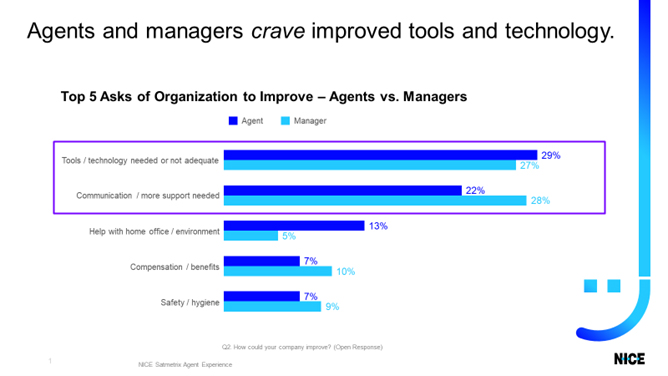Static is annoying. But in a contact center, static (or friction) isn’t just bothersome—it undermines your CX goals.
When I was a kid in the 80s, my mother would spray a canned potion to remove the static from her dresses. This product neutralized the charge of static electricity and eliminated the friction so the fabric wouldn’t cling.
When I think about the most efficient way to eliminate friction from agent and customer interactions, I envision static cling on fabric. I wish we could neutralize the static with a spray—just like that! Remove the friction and create an experience smooth as silk.
But, since no one has yet figured out how to engineer an easy-to-use canned solution to remove CX friction, let’s explore some real-world innovations that you can use today.Take a peek at what’s ahead:
- Conversational AI for winning with customers
- AI can remove friction from the agent experience as well
- Three ways to eliminate friction from the agent experience
- AI tools available now for contact center agents
Conversational AI for winning with customers
Let’s start where most contacts centers place their focus—the customer!
When it comes to removing friction from the customer experience, it’s a safe bet that most people will look to self-service and conversational AI. It makes sense. Many essential use cases are best addressed by simply introducing convenience and letting customers serve themselves. Additionally, self-service is more cost-effective.
When conversational AI is done well, it can seem so natural to people that many won’t even realize they are talking to a bot. The most sophisticated AI assistants can identify customer intent (e.g. their need) based on a few words and provide a tailored response for every different customer.
It’s also true the brunt of contact center volume handled by live agents can be reduced by AI-powered virtual assistants and conversational Interactive Voice Response (IVR). This kind of contact center technology can be used to reduce call handle time by enabling callers to get the answer to their questions via automated self-service, which decreases the waiting time for callers.
But even still, we know that lots of interactions starting out in self-service wind up being transferred to a human. In fact, 81% of customers who start with self-service will end up being transferred to an agent.[1] So no matter how great your self-service is, at the end of the day, there will always be a slice of customer interactions that REQUIRE live assistance. And this means you need to prepare your agents to provide the best possible experience for customers.
AI can remove friction from the agent experience as well
"50% of customers who begin with self-service channels are transferred to a live agent." [2]
According to Gartner, more than 90% of organizations view CX as their primary source of differentiation.[3] Organizations are hyper-focused on creating new and unique customer experiences, but these same organizations often neglect to give the same attention to the employee experience.
In fact, ICMI’s latest research shows that only 50% of organizations prioritize agent experience, and largely in passive ways, like anonymous/blind engagement surveys.[4] That’s not going to help with agent retention.
There’s a whole other strategic angle for contact center managers to consider when it comes to removing friction. That’s right! It’s the agent experience. Yes, I know, I know! CX is all about the customer. Yes, it is. However, my point is that your brand’s CX is only as good as your AX. They are two sides of the same coin.
"Organizations that care about employee wellbeing have 2X the customer satisfaction as reflected in their net promoter score."[5]
There are many conversations that need to be had. So, let’s start talking!
We’ll start with conversational AI. It’s not limited to helping customers via self-service and Intelligent Virtual Assistant (IVA) software. You can also leverage conversational AI in your contact center to help your agents be more successful.
Here are just three examples to get you started.
Three ways to eliminate friction from the agent experience
Here are a few things contact center managers and supervisors can do right now to improve agent experience and slow employee turnover.
1: Equip employees with the right tools and technology
Have you ever known a person who actually enjoys repeating the same information over and over? Or one who likes the chaos of juggling many different apps and screens? Probably not. People feel the same at work. Just like your customers, your contact center agents want effective tools to help them save time and be more efficient in their roles.
"60% of agents lack the tools they need to deliver meaningful CX."[7]
Having the right tools paves the way to a seamless experience for agents and customers. It’s a win-win. So, what ARE the right tools?
Some exciting innovations are happening around the tools available to contact center agents. It’s like agents are finally getting their time in the sun.
A few examples are whisper coaching, workforce optimization software, engagement software, enlightened AI routing, and real-time interaction guidance. More on that later.
2: Remove roadblocks hindering agent experience
It’s not just frustrating for a customer when the agent can’t help them—I’m certain the sentiment is reciprocal. This is particularly true because agents are already getting squeezed by the increasing complexity of customer needs and call volumes.
Handing agents inadequate tools and throwing them into the deep end without a lifejacket perpetuates agent burnout and compounds negative feelings about their work. And is it any wonder?! Just like your customers, your agents embrace technology. Your contact center should too!
"35% of global employees surveyed feel their job is harder than it should be because of outdated processes and legacy technology."[8]
Your agents want to have fulfilling and meaningful interactions at work. Who doesn’t? Technology can help by removing repetitive tasks that plague agent workloads. It can also augment their performance by connecting them to the exact right answer at the right time. This can help lower agent stress levels, which is a good thing for everyone involved.
Agents don’t want to wait around any more than your customers do. They want to proactively make instant changes to their hybrid-work schedules, access customer context, and get real-time coaching. If you prioritize making improvements to the day-to-day tasks of your agents, it can go a long way toward reducing agent turnover.
"Employees spend 25% of their time searching for information."[9]
Agents are also attracted to working remotely. Color us not surprised, right? The appropriate tech can support “productive-from-anywhere” contact center models without sacrificing an ounce of human communication. It means agents can build meaningful relationships with team members and customers while they work from the comfort of home.
"85% of people who feel they can be productive everywhere say that they plan to stay with their company for a long time."[10]
3: Acknowledge the expanded role of contact center agents
For modern contact centers, the role of an agent has evolved significantly in the last five to 10 years to include customer engagement on more channels. For those keeping count, there’s the traditional voice (which isn’t going away!), SMS, email, and asynchronous chat on dozens of next-generation digital and social channels (such as Facebook Messenger and Apple Business Chat).
Your agents are busy. And all these communication channels have become enmeshed in our lives, so it’s not going to change anytime soon.
"50% of organizations report dramatic shifts in responsibilities due to adding channels."[11]
How can contact center agents keep up if their role is expanding to support more functions? Not only are agents handling more complex issues, but they are also needed to support customers throughout their entire journey—end-to-end—from pre-sales advice to onboarding, fulfillment, issue handling, customer recovery, and post-sales support.
The answer is providing your agents with the right AI tools to help them be successful.
AI tools available now for contact center agents
How often do your agents have to ask customers why they are calling after the customer has been transferred from the IVR? Do your agents always know what to do and what to say next in each customer interaction? More often than not, the answers to these questions are not ideal.
These questions also reflect some of the most common pain points for agents and customers. Agents don’t like feeling unprepared, and customers don’t like having to repeat themselves.
Agents who don’t have easy access to answers might give customers the wrong information or get flustered. Seamless transfers from IVR where agents can get customer interaction history will speed up the resolution and keep agents and customers happy.
"70% of contact centers lack access to relevant customer data at the moment of agent interaction."[12]
As for contact center managers, they too can be more efficient with conversational AI. These AI systems can provide deflection to less expensive digital channels to free up valuable agent time that can instead be used to help customers with more complex needs.
Here are just a few of the smart tools that modern contact centers can put at their agents’ fingertips:
- Real-time agent assistance to deliver suggestions on the “next best action”
- Real-time “turn-by-turn” guidance for agents, like GPS directions for driving, but for the contact center
- Intelligent chatbots that serve up articles from the knowledge base without the agent having to manually search
- Timely and personalized coaching to agents on their soft-skill behaviors like active listening and building rapport (human skills that are hard to train and measure)
"49% of workers say they’re likely to leave their current job if they’re unhappy or frustrated with workplace tech".[13]
These tools deliver several benefits to your agents and help make you an employer of choice. Who doesn’t want that? AI can help your agents be more successful through in-the-moment coaching and helping them manage mundane tasks.
Agent job satisfaction gains include:
- Saving them time and reducing frustration and stress
- Decreasing negative customer interactions
- Empowering agents with continuous support
- Boosting agent efficiency and job satisfaction
These tools can also speed up agent onboarding and continue the process of soft skills training. In addition, technology can help contact center managers gain access to data about what’s happening in real-time (instead of ‘after-the-fact’ analysis) and make necessary changes straightaway.
But that’s not all. It gets even better.
Conversational AI can also act as a "whisper agent" to assist your live agents while they are on a call. The human agents can interact with the conversational AI through a chat feature that walks them step-by-step through various procedures. This is a big help. Agents don’t want to sound uninformed, and they don’t want to deal with frustrated customers.
The AI tools necessary to remove agent friction are here and ready for your contact center to use. Your agents (and customers!) deserve the seamless experience these tools can provide. Without them, you can’t possibly compete as an employer of choice following The Great Resignation. And why would you want to? It’s an investment that can save you money over time.
These tools will make life easier for everyone. So. Are you ready to learn more?
Read more about workforce trends shaping 2022.
Download this customer journey map template to access advice from Experience Investigators and start mapping your agent and customer journeys today. This tool can help you get one step closer to delivering proactive CX for today’s digital-first reality. This tool can also help you determine ways to improve agent experience and ultimately enhance CX.
Download map
[1] HBR: Kick-Ass Customer Service (2017)
[2] NICE CXone: Customer Experience (CX) Transformation Benchmark (2020)
[3] Gartner: Global CEO Survey (2020)
[4] ICMI: Agent Experience Maturity Model & Toolkit (2022)
[5] MIT: Building Business Value with Employee Experience (2018)
[6] NICE CXone | Increase agent engagement and improve productivity at home
[7] ICMI: State of Agent Experience and Engagement in Today’s Contact Centers (2018)
[8] The Workforce Institute at Kronos Incorporated: Engaging Opportunity: Working Smarter with AI (2019)
[9] Economist Intelligence Unit (EIU)/Citrix Systems: The Experience of Work: The Role of Technology in Productivity and Engagement (2019)
[10] Accenture: Future of Work Study (2021)
[11] ICMI: State of Agent Experience and Engagement (2019)
[12] Forrester Consulting/Live Vox: Contact Center Leaders Weigh in on the top Challenges to Improving the Agent And Customer Experience (2021)
[13] Adobe Experience Platform: Adobe Experience Platform (2021)






 [6]
[6]



